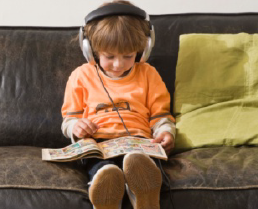Discovering Your Child’s Learning Style

As a homeschooler, you’re probably already aware that there are many different learning styles. Everyone has their preferred method of learning. Whether your are new to homeschooling or are an old pro, a quick review of learning styles can be beneficial.
The common school of thought recognizes three distinct learning styles. These are Visual Learners, Auditory Learners, and Kinesthetic Learners. They may sound like fancy labels, but they are simply different ways of learning.
Most people work best with one learning style, but will find that they may overlap into the other areas. This makes it important to address all learning styles with every student, while focusing on the style that suits them best. It’s also important to keep in mind that your child may not share the same dominant learning style as you do.
 Visual Learners – Visual learners learn through seeing. They learn through reading of text, use of pictures, graphs, diagrams, etc. If your child is a visual learner, you should provide reading material, use body language in your teaching, and instruct your child how to take notes. Use written instructions, rather than oral, and keep background noise to a minimum. Remember that they memorize using visual cues, so they may prefer to write something down, even on an oral assignment. Visual learners tend to recall information better if they have read it to themselves silently before reading aloud or discussing the information. It may be beneficial to provide a visual learner a general outline of the material that will be covered in a discussion or reading. Using concept maps also helps to provide connections of the material.
Visual Learners – Visual learners learn through seeing. They learn through reading of text, use of pictures, graphs, diagrams, etc. If your child is a visual learner, you should provide reading material, use body language in your teaching, and instruct your child how to take notes. Use written instructions, rather than oral, and keep background noise to a minimum. Remember that they memorize using visual cues, so they may prefer to write something down, even on an oral assignment. Visual learners tend to recall information better if they have read it to themselves silently before reading aloud or discussing the information. It may be beneficial to provide a visual learner a general outline of the material that will be covered in a discussion or reading. Using concept maps also helps to provide connections of the material.
 Auditory Learners – These are the children who will benefit from reading the text aloud, listening to a story on a tape recorder, or participating in a discussion. For your auditory learner, you should consider using online stories with audio support, books on tape, or taking turns reading out loud. Auditory learners function well with wordless background music playing while they study. It may be beneficial for your auditory learner to use a finger or a pointer when reading to avoid skipping lines. The auditory learner also benefits from repeating the given directions, performing oral evaluations, and using word association to remember material.
Auditory Learners – These are the children who will benefit from reading the text aloud, listening to a story on a tape recorder, or participating in a discussion. For your auditory learner, you should consider using online stories with audio support, books on tape, or taking turns reading out loud. Auditory learners function well with wordless background music playing while they study. It may be beneficial for your auditory learner to use a finger or a pointer when reading to avoid skipping lines. The auditory learner also benefits from repeating the given directions, performing oral evaluations, and using word association to remember material.
 Kinesthetic Learners – Kinesthetic learners learn best through a hands-on approach. They learn though moving, touching, and doing. If your child is a kinesthetic learner, you may want to consider field trips, laboratory experiments, and using memory techniques involving hand gestures. Kinesthetic learners need to work in shorter blocks of time and take frequent breaks while studying. They tend to need space to read or write, such as laying on the floor or bed as opposed to sitting at a table. Kinesthetic learners tend to favor action-oriented books. To encourage your kinesthetic learner, allow for the use of models, projects, or demonstrations as opposed to the traditional written report.
Kinesthetic Learners – Kinesthetic learners learn best through a hands-on approach. They learn though moving, touching, and doing. If your child is a kinesthetic learner, you may want to consider field trips, laboratory experiments, and using memory techniques involving hand gestures. Kinesthetic learners need to work in shorter blocks of time and take frequent breaks while studying. They tend to need space to read or write, such as laying on the floor or bed as opposed to sitting at a table. Kinesthetic learners tend to favor action-oriented books. To encourage your kinesthetic learner, allow for the use of models, projects, or demonstrations as opposed to the traditional written report.
Discovering your child’s learning style will not only benefit your child, but you, the homeschooling parent as well. Having this knowledge will help you determine what learning style is best and how to incorporate that style into your student’s Calvert curriculum. Most importantly though, knowing how your child learns will foster confidence and encourage a lifelong love of learning in your child.
Is your child’s current learning environment not the right fit?
At Calvert Education, we understand that students learn differently. Our Education Counselors are available to all enrolled families for free consultations to help you with teaching strategies, to answer specific curriculum questions, to offer practical advice on how to help students stay focused, and to help you customize lessons and curriculum that best meet your child’s needs.
Now is the best time to make the switch to homeschooling!
